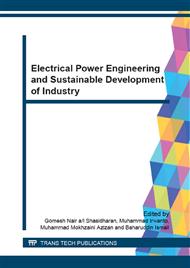p.304
p.309
p.315
p.323
p.328
p.333
p.338
p.343
p.348
Development of Dual Axis Solar Tracking System Performance at Ulu Pauh, Perlis
Abstract:
Theoretically, the solar tracking system describe as the device to get the optimize amount of sunlight according to sun movement. So, the shading effect issues can be minimized. This paper is presents the finding of photovoltaic (PV) harvesting energy via dual axis tracking system. The operation of two direct current (DC) motors motion was programme using PIC kit SK40C by using the Lab View Programming software. The first motor system delay timer is set at 15° rotation per hour and second motor system delay timers is set to rotate 180° after 12 pm. The field testing was initially set up at Perlis, Malaysia climate. An actual testing was used to collect the daily data. The result shows that, the output voltage with solar tracking system is 12.93% higher than without tracking system in the sunny day condition.
Info:
Periodical:
Pages:
328-332
Citation:
Online since:
September 2015
Authors:
Price:
Сopyright:
© 2015 Trans Tech Publications Ltd. All Rights Reserved
Share:
Citation:


